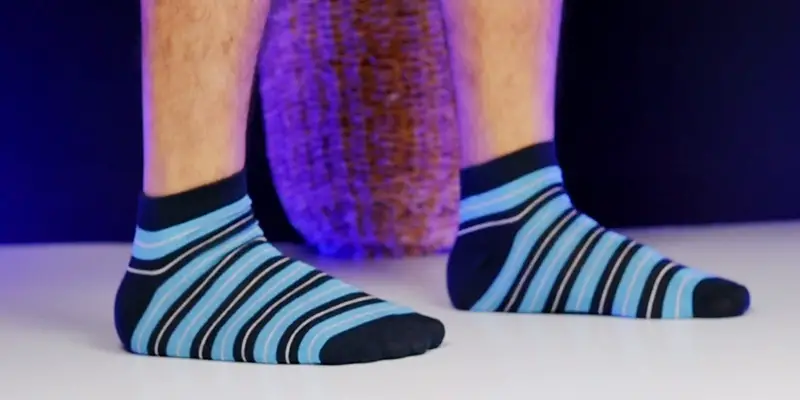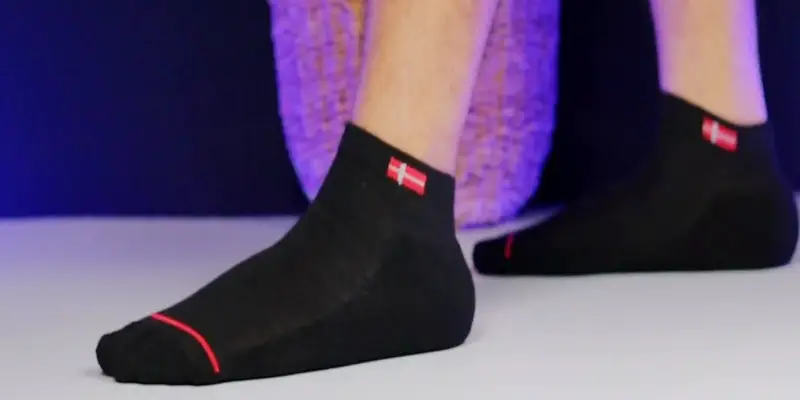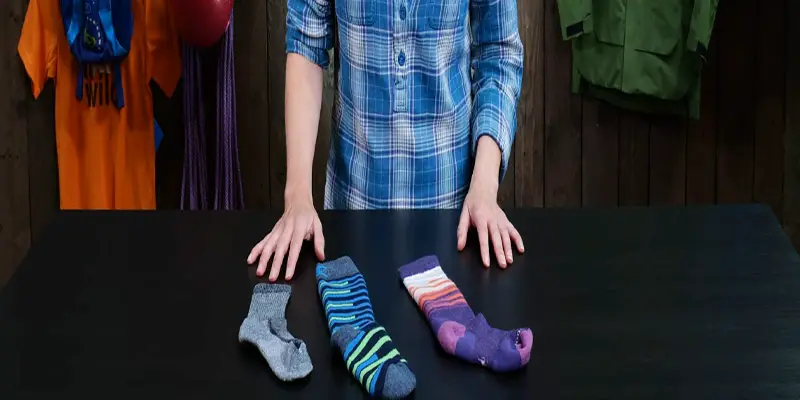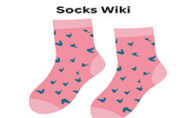Hi, I'm Christopher Bevans, the creator of SocksWiki.com. With a background in fashion design and a passion for innovation, I’m here to share my knowledge on socks from troubleshooting tips to detailed buying guides. I believe the right pair of socks can make all the difference, and through this site, I aim to help you find the perfect fit for every occasion.
Hi, I'm Christopher Bevans, the creator of SocksWiki.com. With a background in fashion design and a passion for innovation, I’m here to share my knowledge on socks from troubleshooting tips to detailed buying guides. I believe the right pair of socks can make all the difference, and through this site, I aim to help you find the perfect fit for every occasion.
It has been a viral question What are socks? Well, socks are essential garments worn on the feet, typically made from materials like cotton, wool, or synthetic fibers.
They provide comfort, warmth, and protection, absorbing moisture and reducing friction between the foot and footwear.
The term “sock” refers to a single piece, while “socks” denote a pair or multiple pieces. Socks come in various styles, lengths, and materials, catering to different activities and fashion preferences.
Whether for daily wear, sports, or formal occasions, socks play a crucial role in foot health and comfort, making them an indispensable part of our wardrobes.
Sock or socks What Is the Correct Spelling?
The words “sock” and “socks” are both correct spellings, but they refer to different forms of the word and are used in different contexts:
Sock
“Sock” is the singular form of the word and refers to one piece of foot covering. For example, “I lost one sock in the laundry.”
Socks
“Socks” is the plural form and refers to more than one piece of foot covering. For example, “I bought a new pair of socks.”
What Are Socks Called?

Socks are a common type of garment worn on the feet, typically made from a variety of materials such as cotton, wool, nylon, or synthetic fibers.
They serve multiple purposes, including providing comfort, warmth, and protection to the feet, as well as absorbing moisture and reducing friction between the foot and footwear.
The name “socks” comes from the Old English word “socc,” which referred to a light slipper.
The term has evolved over time, but it generally refers to any kind of foot covering that fits snugly and extends over the foot and sometimes the lower leg.
Different types of socks are known by various names based on their design, length, and intended use. Some common types include:
Ankle Socks
These socks reach just above the ankle bone and are often worn for casual or athletic purposes.
Crew Socks
Crew socks extend to the mid-calf and are commonly used for everyday wear, sports, and activities that require more coverage.
Knee-High Socks
As the name suggests, these socks reach up to the knee and are often worn for warmth or as part of a uniform.
No-Show Socks
These are low-cut socks designed to be invisible when worn with shoes, providing a minimalist look while still offering protection and comfort.
Dress Socks
These are typically thinner and made from finer materials, intended to be worn with formal or business attire.
Compression Socks
Specially designed to improve blood circulation, compression socks are often used for medical purposes or by athletes.
What Are Socks for Men?
Socks for men are an essential part of a man’s wardrobe, providing comfort, protection, and style. They come in various styles, materials, and lengths, catering to different occasions, preferences, and needs.
Here’s an overview of what socks for men are and their key features:

Purpose and Functionality of Men’s Socks
Men’s socks serve several functional purposes, such as providing a layer of cushioning between the foot and the shoe, absorbing moisture, and preventing blisters and abrasions. They help keep feet warm in cold weather and cool in warmer conditions.
Additionally, socks protect the feet from dirt and bacteria and can also play a role in maintaining foot hygiene by wicking away sweat and moisture.
Types of Men’s Socks
Men’s socks come in a variety of styles, each suited for different occasions and purposes:
Dress Socks
Typically worn with formal or business attire, dress socks are usually made from finer materials like cotton, wool, or silk.
They are often thinner than other types of socks and come in solid colors or subtle patterns to complement suits and dress shoes.
Casual Socks
These are everyday socks that come in a wide range of styles, colors, and patterns. They are usually made from comfortable, durable materials like cotton or blends and can be worn with casual footwear, such as sneakers or loafers.
Athletic Socks
Designed for sports and physical activities, athletic socks often feature extra cushioning, moisture-wicking properties, and support in areas like the arch and heel. They are typically made from synthetic blends to enhance breathability and durability.
Ankle Socks
Also known as “no-show” socks, these are low-cut socks that sit just above or below the ankle. They are popular for casual wear, particularly with shorts or low-cut shoes, as they provide comfort without being visible above the shoe line.
Crew Socks
A versatile style, crew socks extend up to the mid-calf and are suitable for both casual and athletic wear. They offer good coverage and are often worn with sneakers, boots, or casual shoes.
Knee-High Socks
These socks extend up to the knee and are often used for warmth in colder weather or as part of a uniform. They can also be worn for certain sports, like soccer or skiing, where additional leg coverage is beneficial.
Compression Socks
Designed to improve circulation and reduce swelling, compression socks apply gentle pressure to the legs and feet. They are often used by athletes, travelers, or individuals with medical conditions that affect blood flow.
Materials and Fabric Choices for Men’s Socks
The choice of material in men’s socks affects their comfort, durability, and functionality. Common materials include:
- Cotton: A popular choice for its softness and breathability, cotton is often blended with synthetic fibers to enhance its durability and moisture-wicking properties.
- Wool: Known for its excellent insulation and moisture-wicking abilities, wool is ideal for colder weather. Merino wool, in particular, is prized for its softness and ability to regulate temperature.
- Synthetic Blends: Materials like polyester, nylon, and spandex are often blended with natural fibers to improve elasticity, durability, and moisture management. These blends are commonly used in athletic and performance socks.
- Silk: While less common, silk socks are sometimes chosen for their luxurious feel and ability to add a touch of elegance to formal attire.
Fashion and Style of Men’s Socks
Socks have become a key element in men’s fashion, allowing for expression of personal style. From classic solid colors and understated patterns to bold, vivid designs, there is a wide range of options to suit different tastes and occasions.
Patterned socks can add a pop of color or a playful touch to an outfit, while classic styles remain a staple for professional settings.
Special Considerations
When choosing socks, men may consider factors like the sock’s intended use, the type of shoes they will be worn with, and specific foot care needs.
For instance, individuals with sensitive skin or specific health conditions might opt for socks with non-binding tops or seamless designs to avoid irritation.
What Are Socks for Women?

Socks for women are an essential component of daily attire, offering both functionality and style.
Like men’s socks, women’s socks serve several important purposes, such as providing comfort, protection, and moisture management for the feet.
However, they also cater to specific fashion trends and preferences, offering a wide variety of designs, lengths, and materials to suit different occasions and styles.
Here’s an overview of what socks for women are and their key features:
Purpose and Functionality of Women’s Socks
Women’s socks are designed to provide comfort and protection for the feet. They offer cushioning and help prevent blisters and abrasions by reducing friction between the feet and shoes.
Socks also play a crucial role in keeping feet warm in colder weather and cool in warmer conditions, depending on the material.
Additionally, they absorb moisture from sweat, helping to maintain foot hygiene and prevent unpleasant odors.
Types of Women’s Socks
Women’s socks come in a wide range of styles, each designed for specific occasions, activities, or personal preferences:
Dress Socks
These socks are typically thinner and made from fine materials like silk, nylon, or blends of cotton and spandex.
They are often worn with dress shoes or heels and come in various lengths, from ankle to knee-high.
Dress socks for women are available in a range of colors and subtle patterns, complementing formal or business attire.
Casual Socks
Ideal for everyday wear, casual socks are made from comfortable, breathable materials like cotton or cotton blends.
They come in a wide array of styles, including ankle socks, crew socks, and knee-high socks.
These socks often feature fun patterns, colors, and designs, allowing women to express their personality and style.
Athletic Socks
Designed for physical activities, athletic socks for women often feature extra cushioning, arch support, and moisture-wicking properties.
Athletic socks are typically made of synthetic blends that enhance durability and breathability, making them suitable for sports, workouts, and other active pursuits.
No-Show Socks
Also known as low-cut or invisible socks, these are designed to be worn with low-cut shoes like ballet flats or sneakers, remaining hidden from view.
No-show socks provide the comfort and protection of regular socks without being visible, making them a popular choice for casual and sporty outfits.
Knee-High and Over-the-Knee Socks
These socks extend up to the knee or beyond and can be worn for both functional and fashion purposes.
They provide extra warmth and coverage, making them ideal for cooler weather or as part of a stylish outfit.
Over-the-knee socks, in particular, have become a trendy accessory, often paired with skirts, dresses, or shorts.
Tights and Hosiery
While not traditional socks, tights and hosiery are often included in the category of legwear. They offer full leg coverage and come in various styles, including opaque, sheer, patterned, and textured.
Tights and hosiery are commonly worn with skirts and dresses, providing a polished look and additional warmth.
Compression Socks
Similar to those designed for men, compression socks for women are used to improve blood circulation, reduce swelling, and provide support.
They are especially useful for those who stand for long periods, during travel, or for individuals with certain medical conditions.
Materials and Fabric Choices for Women’s Socks
The choice of material in women’s socks affects their comfort, durability, and suitability for different occasions:
- Cotton: A popular material for its softness and breathability, cotton is often blended with synthetic fibers to enhance durability and moisture-wicking properties. Cotton socks are versatile and suitable for everyday wear.
- Wool: Known for its insulating properties, wool is ideal for colder weather. Merino wool, in particular, is prized for its softness and ability to regulate temperature, keeping feet warm without causing overheating.
- Synthetic Blends: Materials like polyester, nylon, and spandex are often used in blends to create socks that are durable, stretchy, and quick-drying. These materials are commonly found in athletic and performance socks.
- Silk: Silk socks are luxurious and offer a smooth, soft feel. They are less common but are sometimes chosen for their elegant appearance and lightweight comfort, especially in dress socks.
Fashion and Style of Women’s Socks
Socks for women are available in a vast array of designs, allowing them to be a fashion statement or complement to an outfit.
From classic solid colors to bold patterns and prints, women’s socks can add a pop of color or an interesting detail to an ensemble.
Seasonal themes, holiday motifs, and trendy designs are popular, providing options for every taste and occasion. Fashion socks can be playful, elegant, or understated, catering to a wide range of styles.
Special Considerations for Women’s Socks
When choosing socks, women may consider factors like the intended use, the type of shoes they will be paired with, and any specific foot care needs.
For example, socks with seamless toes can help prevent irritation, while socks with non-binding tops are beneficial for those with circulation issues.
Additionally, the choice of sock length and thickness can be influenced by the weather and the type of outfit.
What Are Socks for Kids?

Socks for kids are designed to provide comfort, warmth, and protection for young feet. They come in a variety of styles, materials, and colors to suit different needs and preferences.
Kid-friendly socks often feature soft, breathable materials like cotton blends to ensure comfort and prevent irritation.
They come in fun patterns and bright colors, making them appealing to children and easier to match with outfits.
Different types include ankle socks, which are great for everyday wear, and knee-high socks, which provide extra warmth in colder weather.
Many kids’ socks have elastic bands that help keep them in place without being too tight. Specialized socks, like those with reinforced heels and toes, are designed to withstand the wear and tear from active play.
Overall, socks for kids combine practicality with playful designs, ensuring that children stay comfortable and stylish throughout their daily activities.
Why Are Socks Made?
Socks are made for several practical and functional reasons, providing comfort, protection, and hygiene for the feet.
Here are some key reasons why socks are made and worn:
Protection and Comfort
Socks offer cushioning between the foot and the shoe, absorbing impact and reducing pressure while walking, running, or standing. This helps prevent discomfort and blisters.
They also provide warmth, especially in cooler climates or during colder seasons, with materials like wool being particularly effective at keeping feet warm.
Moisture Management
Socks absorb moisture from the feet, which have numerous sweat glands, keeping them dry and reducing the risk of skin irritation and infections like athlete’s foot.
Some socks are made from breathable materials, allowing air circulation and keeping feet cool and comfortable during physical activities.
Hygiene
Socks act as a barrier between the feet and shoes, preventing the buildup of bacteria and fungi inside the footwear. This not only helps maintain foot hygiene but also extends the life of the shoes.
Reducing Friction and Blisters
The smooth surface of socks reduces friction between the foot and shoe, which can otherwise lead to blisters and chafing. This is particularly important for athletes and people who are on their feet for long periods.
Support and Compression
Some socks are designed with additional support features, such as arch compression or padded heels, providing extra stability and reducing strain on the feet.
Compression socks apply pressure to the legs and feet, improving blood circulation and reducing swelling. These are often used for medical purposes or by people who stand or sit for extended periods.
Fashion and Expression
Beyond their functional purposes, socks are also a fashion accessory. They come in various colors, patterns, and designs, allowing individuals to express their personal style and add a unique touch to their outfits.
In some cultures, socks have specific traditional or ceremonial significance and are worn as part of traditional attire.
Specialized Uses
Socks designed for specific sports, such as running, hiking, or cycling, have specialized features to enhance performance, like moisture-wicking materials, extra cushioning, or reinforced areas.
Certain socks are also designed for medical needs, such as diabetic socks, which have non-binding tops and are made from materials that minimize irritation and provide additional protection for sensitive feet.

Hi, I'm Christopher Bevans, the creator of SocksWiki.com. With a background in fashion design and a passion for innovation, I’m here to share my knowledge on socks from troubleshooting tips to detailed buying guides. I believe the right pair of socks can make all the difference, and through this site, I aim to help you find the perfect fit for every occasion.
- Latest Posts by Christopher Bevans
-
Socks Care Label Symbols and Meanings: 5 Explained
- -
Smartwool vs Darn Tough Socks: Hiking, Running, Women & Men
- -
Socks Storage Ideas: 10 Real-Life DIY Ideas
- All Posts


